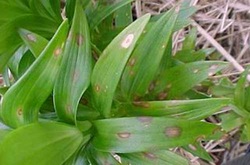 What the heck is wrong with my lily?
What the heck is wrong with my lily? With Spring finally here and our lily bulbs poking their heads up through the soil, it is now time to start watching for the most common disease of lilies Botrytis.
Botrytis is a fungal disease that affects the stems, leaves and in extreme cases, the flowers and buds of lilies and is spread by spores located on the undersides of the leaves, on the ground, and in old garden debris.
The spores are spread by wind and rain or water splashing up onto the lilies, and are encouraged by damp, wet and humid conditions, which we often see in June on our prairies.
Beginning as a small white or brown spot on a leaf or bud, the spot grows into a larger brown spot with a lighter center, until it engulfs the entire leaf and then the stem and buds, if action is not taken. The damage can be held back or avoided by using preventative sprays of chemical or organic nature.
This disease is limited to the plant growth above ground, and does not carry over into the bulb from year to year. However if
the stems are completely affected and totally brown to the tip early in the summer, the bulbs do not increase in size. It will sprout and grow again the next year. but if Botrytis is experienced 3 years in a row, under extreme conditions where the stems are totally brown by mid summer, the following year the bulbs will not sprout, their quality seriously deteriorated due to the ongoing disease.
So lily growers be always wary of this deadly disease lurking!
"The modest Rose puts forth a thorn,
The humble sheep a threat'ning horn:
While the Lily shall in love delight,
Nor a thorn nor a threat stain her beauty bright."
by William Blake
.
Botrytis is a fungal disease that affects the stems, leaves and in extreme cases, the flowers and buds of lilies and is spread by spores located on the undersides of the leaves, on the ground, and in old garden debris.
The spores are spread by wind and rain or water splashing up onto the lilies, and are encouraged by damp, wet and humid conditions, which we often see in June on our prairies.
Beginning as a small white or brown spot on a leaf or bud, the spot grows into a larger brown spot with a lighter center, until it engulfs the entire leaf and then the stem and buds, if action is not taken. The damage can be held back or avoided by using preventative sprays of chemical or organic nature.
This disease is limited to the plant growth above ground, and does not carry over into the bulb from year to year. However if
the stems are completely affected and totally brown to the tip early in the summer, the bulbs do not increase in size. It will sprout and grow again the next year. but if Botrytis is experienced 3 years in a row, under extreme conditions where the stems are totally brown by mid summer, the following year the bulbs will not sprout, their quality seriously deteriorated due to the ongoing disease.
So lily growers be always wary of this deadly disease lurking!
"The modest Rose puts forth a thorn,
The humble sheep a threat'ning horn:
While the Lily shall in love delight,
Nor a thorn nor a threat stain her beauty bright."
by William Blake
.

 RSS Feed
RSS Feed